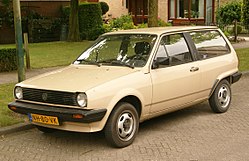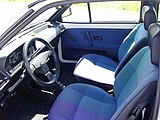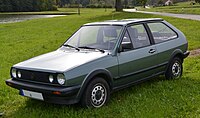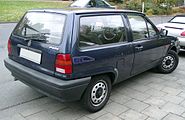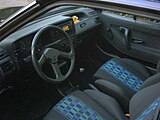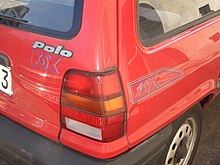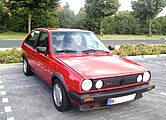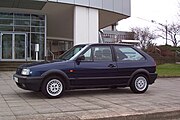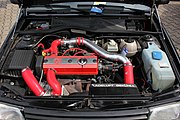VW Polo II
| Volkswagen | |
|---|---|
|
VW Polo (1981–1990)
|
|
| Polo II (type 86C) | |
| Production period: | 1981-1994 |
| Class : | Small car |
| Body versions : | Station wagon , limousine , station wagon coupé |
| Engines: |
Petrol engines 1.0–1.3 liters (29–85 kW) Diesel engines 1.3–1.4 liters (33–35 kW) |
| Length: | 3655 or 3725 mm |
| Width: | 1570 mm |
| Height: | 1325-1350 mm |
| Wheelbase : | 2335 mm |
| Empty weight : | 725-830 kg |
| Previous model | VW Polo I. |
| successor | VW Polo III |
The Polo 86C (or Polo II ) is a vehicle model from Volkswagen that was manufactured around 1.7 million times in total in the Wolfsburg , Mosel and Pamplona (Spain) plants from September 1981 to July 1994 . It was only available with three doors with a steep or hatchback (coupe), with four or five-speed manual transmission, front-wheel drive and a transverse engine at the front. There was a choice of gasoline engines from 29 kW (40 PS) to 85 kW (115 PS) or diesel engines with 33 kW (45 PS) and 35 kW (48 PS). The main characteristic of the Polo II are the front triangular windows, which were not removed (as was the case after a revision on the Golf II in the summer of 1987).
The second-generation Polo models have made a name for themselves as inexpensive and robust small cars, especially among novice drivers and minimalists. Towards the end of the construction period, the safety equipment was no longer up-to-date and the comfort equipment was mostly kept economical.
Model history
General
The Polo 86C was built for a total of 13 years - almost as long as the predecessor 86 and the successor 6N combined. In addition to the major facelift in October 1990, the Polo went through several small "lifts". Vehicles for the non-German market usually have the type designation 87C , which they keep even when they are reimported to Germany.
Three examples for the models up to autumn 1990:
The first polos had thin, partially chrome-plated plastic strips - if they had any - relatively high up over the entire length of the vehicle. Later there were only plastic bumper strips between the wheel arches at the height of the bumpers. The large steering wheels with a thin, bony steering wheel rim were also among the first Polos. In the course of time, all Polos got smaller, thickly foamed steering wheels. The reversing lights were also changed: the first models only had a small illuminated area with a red frame, while a completely white diffuser was introduced later .
1981-1990: Polo 86C
In October 1981 VW presented the successor to the first generation of the Polo, which was initially only available with a hatchback . With a trunk that is generous for this class and which can be enlarged by folding down the rear seat, even goods the size of a washing machine can be transported. The first vehicle left the Wolfsburg plant on September 17, 1981.
In the beginning, the Polo was available in the equipment versions C , CL and GL with the following engines:
- 1.05 l - 29 kW (40 hp)
- 1.1 l - 37 kW (50 hp)
- 1.3 l - 44 kW (60 hp)
- Formula E with higher compression , rear spoiler lip and economy indicator based on the 50 hp engine
In February 1982 the notchback version Derby was reissued . The third body variant, the Polo Coupé, followed in August 1982. It differs from the hatchback in that it has a flatter sloping rear window and was designed more for sportiness from the start. This is why the newly developed 1.3 l 55 kW engine (75 hp) was initially only available for the Coupé in the new GT equipment variant, and the Coupé was also available as CL and GL . Even today, the coupé is the most popular body variant of all Polos.
In August 1983 a new 1.3-liter engine ( VW EA111 ) with 40 kW (54 PS) replaced the previous engines with 50 and 60 PS.
In March 1984, production of the Polo began at the Seat Pamplona (Spain) plant, which was later acquired by Volkswagen AG. In August 1984 the upscale GL version was discontinued. In return, the CL equipment was upgraded. The Polo Coupé was now also available with the 29 kW engine and the GT equipment was now also available with the 40 kW engine. At the same time, Volkswagen introduced the new car radio generations alpha , beta and gamma .
In January 1985, the derby was renamed Polo Notchback . At the same time he got round headlights.
From August 1985 the city delivery van could be ordered with truck registration. Instead, you got a hatchback without a rear seat, but with unglazed side walls, load compartment cladding and grille behind the front seats. Small craft businesses or retailers in particular should be addressed. In addition, it was now possible to order the Coupé in the C version.
In the same month, the 1.05 liter 29 kW engine (40 hp) was replaced by a new 1.05 liter 33 kW engine (45 hp). In addition, the coupe was presented as the GT G40 as the top model .
In July 1986 VW introduced a 1.3-liter diesel engine with 33 kW (45 hp) for the Polo. One month later, in August 1986, equipment variant C was discontinued .
From August 1987, the Polo was limited to three equipment variants - Fox , CL and GT . The CL variant has been slimmed down a bit, the GT has been upgraded a bit. The Fox was created as a new basic model from a former special model. The 1.3 l 55 kW engine (75 hp) was now also available for the hatchback .
The Polo notchback and the city delivery van were no longer available for the German market from August 1988. In return, the 45 and 55 hp engines received a catalytic converter that was only available for the 75 hp engine from October 1989.
In August 1989 VW upgraded all model variants.
As the last change to the model range before the major facelift , an electric folding sunroof was available as an option from April 1990. From May 21, 1990, the Polo was also assembled in Mosel : initially by the IFA Combine PKW, in the then still existing GDR . From August 1990 a new 1.4 l 35 kW diesel engine (48 hp) was installed.
With the Polo 86C, a one-make cup in motorsport was held from 1983 to 1989 under the name "International Wintershall VW Polo Cup" as the successor to the Golf GTI Cup. From 1983 to 1985, Polo Coupés were launched with 1.3-liter engines which, thanks to a Solex double carburetor, developed 88 hp (65 kW). From 1986 to 1989 there was a G40 engine with 115 PS (82 kW) (engine code MM) and a regulated catalytic converter, which accelerated the 750 kg coupés from 0 to 100 km / h in 8.4 seconds. The 13-inch light alloy wheels in the design of the VW logo were characteristic of the Cup Polos.
1990–1994: Polo 86C "2F"
In October 1990 a comprehensive facelift of the Polo took place. A new dashboard with more shelves, a higher radio slot, rotary controls for heating and ventilation and redesigned instruments found space in the interior. In addition, with the facelift, new steering wheels, fully clad doors and rear side panels, new pitman arms and, for the first time, two front loudspeaker shafts were installed.
The outside of the Polo has also been redesigned. The bumpers were made larger in order to make them less sensitive to small damage. The front end and the rear end were redesigned, which necessitated a change in the side parts in the connection area to the rear end of the car. Larger angular headlights provide up to 50% more illumination of the road and larger rear lights for more active safety. With the 86C "2F", the front indicators were mounted next to the headlights so that they could also be seen from the side. The c w value of the Polo 86C was improved by 10% in 1990. For this purpose, the rear window of the hatchback and coupé was glued flush and the front end was rounded off. Therefore, it is often as Polo 2F ( F referred acelift).
The revised Polo was again available as a city delivery van (type designation 86CF) but not with a notchback in Germany and Austria . In Germany, only Deutsche Telekom had truck-registered Polo Coupés. The Telekom Polo had no side windows welded shut, a different loading area than the hatchback, and the partition wall not only went up to headrest height, but also ended up flush with the headliner.
The introduction of the successor to the Polo 86C, the Polo 6N (or the real Polo 3) was planned by VW earlier than 1994, but due to the enormous success of the Polo 2F, the plans were postponed several times. In particular, various special models such as the Polo “Genesis” with particularly sporty special equipment ex works and special colors in the interior ensured high sales figures. Other attractive special models included the Polo Boulevard, Universal, Style, Scot and GT Extra.
On September 12, 1991, assembly of the Polo in Mosel was stopped again. Since May 1990 a total of 17,978 polos have been produced in Mosel.
In August 1991 the equipment variants Fox , CL , GT & G40 were upgraded.
All Polos received stiffeners in the doors to protect against side impacts and also automatic three-point seat belts on the outer rear seats as well as side indicators.
Further equipment improvements were: Fixed luggage compartment cover and front passenger sun visors with make-up mirrors for the Polo Fox, internally adjustable exterior mirrors for Fox and CL, side luggage compartment trim and three-spoke steering wheel for CL. From CL equipment there is a holder for first aid kit and warning triangle; In the GT, the driver's seat is height-adjustable. Fog lights, white front indicators and partially darkened rear lights are fitted as standard in the Polo G40, and the model also received a leather cover on the steering wheel and gear lever. The electric folding sunroof was removed from the model range with model year 1992 (from August 1991).
The last Polo 86C rolled off the assembly line in July 1994 . The successor was the Polo 6N .
Fox
In July 1984, Volkswagen launched the spartan Fox special model . It cost around 1,000 DM less than the C model and was intended to appeal to customers who had previously chosen a Beetle because of its low price. The 29 kW motor was used in conjunction with a 4-speed manual transmission. Extras such as a clock, trip meter, cigarette lighter, glove compartment flap, lockable fuel cap and fixed hat shelf (this was designed as a stretch cloth) were dispensed with. A fashionable design should also appeal to younger customers.
From the outside, the Fox can be recognized by the Fox lettering, the colors turquoise blue or saima green and the matching painted steel wheels, later plastic hub caps , in white or saima green . Seats, door panels and stretching cloth were done in the same color as the car.
In 1985, the exterior colors alpine white and - for an extra charge - black were added, although the interior was initially turquoise blue or saima green . Outside mirrors on the passenger side, brake booster , halogen headlights and radios were now available as extras . In the 1986 model year, the colors tornado red and cloud gray replaced the original colors turquoise blue and saima green , the engine output rose from 29 to 33 kW, and the list of extras that could be ordered was also expanded.
From March 1986 the Coupé was also available as a Fox , and variants with exhaust gas purification and 5-speed manual transmission complemented the model range. From August 1986, the Fox rounded off the lower end of the Polo range as a normal equipment variant.
Even after the major facelift in 1990, the Fox economy model was retained. The side indicators were not installed as standard.
The Fox trim level was no longer available for the Polo III . From 2005 to 2011 the name was used for an independent vehicle, the VW Fox . This was positioned below the now much larger Polo IV.
G40
As the most powerful variant of the Polo Coupé , the 'G40' with 85 kW (115 PS) at 6000 rpm and a torque of 148 Nm at 3600 rpm based on the 1.3-liter engine was presented in August 1985. The extra power is built up by a scroll compressor ( G-charger ) , which acts as a compressor . The intake air is compressed by the belt-driven G-charger, which means that more fuel can be injected without the mixture becoming greasy. Contrary to the manufacturer's statements, the G-Lader is not maintenance-free. Depending on the speed and mileage, various structural components wear out, which can lead to restricted functionality or even destruction of the G-Lader. However, the function of the G-Lader can often be secured for several hundred thousand kilometers through regular, moderate overhauls with suitable spare parts.
An upper performance limit was set during development. In order not to exceed the load capacity of the standard 5-speed gearbox, the engine was not allowed to deliver more than 150 Nm of torque, as the new development of a more powerful gearbox would have been too expensive. In order to bring the performance to the road, the intercooled GT G40 has an adapted chassis with a body lowered by 30/20 mm (VA / HA), internally ventilated disc brakes at the front and tires measuring 175/60 R 13 on aluminum wheels. Furthermore, the front axle has been improved with UniBall bearings on the wishbones and tie rods.
In May 1987, a special series of 500 black Polo Coupé GT G40s based on the "old" Polo 86C left the factory for the first time. He received a speedometer up to 240 km / h with a trip meter. The vehicle key number was 719. A year later, due to the great demand, 1500 vehicles were produced, 500 of which were delivered to France. The coupé was now also available in the colors white, tornado red, traffic purple, blue (helios blue metallic) and black. It was not until January 1991 that the Polo G40 , as it was only called since then, based on the Polo 2F, was included in the regular model range. The car initially cost 25,690 DM . Due to the catalytic converter, the output shrank from 85 kW (115 PS) to 83 kW (113 PS). The hallmarks of the G40 were BBS aluminum wheels in size 5½ J × 13, all-round bumper strips and fender flares, a roof antenna, red decorative stripes in the bumpers, G40 emblems in the radiator grille and on the tailgate, sports seats with checkered Le Mans covers and a speedometer up to 240 km / h. From August 1991, fog lights and white indicators, partially darkened taillights, as well as leather steering wheel and leather gear knob were also standard. The vehicle key number was 844.
Eco polo
The test vehicle called Öko-Polo was also equipped with a G-Lader . Of this near-series model series of the 86C, exactly 50 of the 70 planned copies were built in 1988, which were tested in everyday life by public institutions (public order office, charitable institutions). This variant was always delivered in the color alpine white with rainbow stripes on the sides; the eco-polo was aerodynamically optimized only with a small front spoiler. Inside, apart from the lack of a clutch pedal and the boost pressure display, everything was the same as in the production version, only a few special instruments indicate the special technology. The model was designed for maximum economy and had a diesel engine with 860 cm³ displacement. The two-cylinder with direct injection was calmed while running with a balance shaft and counterweights on the crankshaft . The G-Lader from the G40 switched on electrically when required and increased the output from 27 HP to 40 HP. The Polo reached a top speed of 138 km / h. With the semi-automatic 5-speed gearbox from the Spar- Golf , the Eco-Polo was able to achieve a standard consumption of 3.6 liters. On a test drive by the auto magazine Auto Motor und Sport , which led at a slow pace (around 60 km / h on average) from Wolfsburg to Marseille , the vehicle consumed just 1.7 liters per 100 kilometers. This was also achieved through the first-time use of an electronic start-stop system, which switched off the engine in push mode and at traffic lights. In addition, VW tested a soot particle filter in the Eco-Polo, which cleaned itself with additives in the fuel, as well as exhaust gas recirculation to reduce NOx emissions. The additive was necessary because the small engine did not develop enough heat in city and short-distance operation to dissolve the particles in the exhaust filter itself. Despite successful tests, the car was never built in series because the fuel price at the time was not economical. However, some findings were used for the later 3L Lupo and the Golf III Ecomatic.
Derby
The Derby , produced from the end of 1981, had a notchback with a conventional trunk and rectangular headlights. The equipment and engines are the same as the Polo.
In August 1984 the Derby lost its rectangular headlights as a distinguishing feature and from then on also had round headlights.
In January 1985 the name Derby was dropped . Since then, the notchback variant has also run as a Polo .
From August 1988 the Polo notchback was no longer offered in Germany and Austria , but continued to be offered in the Benelux countries, among others , where it was also revised in autumn 1990. In Switzerland and Finland the derby ran under the name Polo Classic .
Technical specifications
| VW Polo II | 1.0 (40 hp) |
1.0 (45 HP) |
1.1 (50 HP) |
1.1 Formula E. |
1.3 (60 hp) |
1.3 (55 HP) |
1.3 Formula E |
1.3 (55 HP) |
1.3 GT | GT G40 (with cat.) |
1.3 G40 | 1.3 Diesel |
1.4 Diesel |
|---|---|---|---|---|---|---|---|---|---|---|---|---|---|
| Construction period | 1981-1985 | 1985-1994 | 1981-1983 | 1983-1989 | 1984-1985 | 1990-1994 | 1982-1994 | 1990-1994 | 01 / 1987-08 / 1990 | 1988-1990 | 1990-1994 | ||
| engine | 4-cylinder in-line engine (four-stroke) | ||||||||||||
| Displacement | 1043 cc | 1093 cc | 1272 cc | 1391 cc | |||||||||
| Bore × stroke | 75.0 x 59.0 mm | 69.5 x 72.0 mm | 75.0 x 72.0 mm | 75.0 x 78.7 mm | |||||||||
| Max. Power at 1 / min | 29 kW (40 PS) at 5300 rpm | 33 kW (45 PS) at 5600 rpm | 37 kW (50 PS) at 5600 rpm | 44 kW (60 PS) at 5600 rpm | 40 kW (55 PS) at 5400 rpm | 40 kW (55 PS) at 5200 rpm | 55 kW (75 PS) at 5900 rpm | 83 kW (113 PS) at 6000 rpm | 85 kW (116 hp) at 6000 rpm | 33 kW (45 PS) at 4900 rpm | 35 kW (48 PS) at 4500 rpm | ||
| Max. Torque at 1 / min | 73 Nm at 2700 rpm | 73 Nm at 3600 rpm | 75 Nm at 3500 rpm | 80 Nm at 3300 rpm | 93 Nm at 3500 rpm | 94 Nm at 3400 rpm | 95 Nm at 3000 rpm | 99-102 Nm at 3600 rpm | 150 Nm at 3600 rpm | 148 Nm at 3600 rpm | 73 Nm at 3100 rpm | 82 Nm at 2700-3500 rpm | |
| Mixture preparation | 1 downdraft carburettor | 1 register downdraft carburettor | electr. Mono-Motronic injection | 1 register downdraft carburettor (from 1990: electrical injection Digifant) |
electr. Injection Digifant, scroll charger (boost pressure 0.68 bar) | Distributor injection pump | |||||||
| Valve control | overhead camshaft, toothed belt | ||||||||||||
| cooling | Water cooling | ||||||||||||
| transmission | 4-speed gearbox | 4- or 5-speed gearbox | 4-speed gearbox | 4-speed gearbox (from 1986: 5-speed) |
4-speed gearbox | 4- or 5-speed gearbox | 4-speed gearbox (from 1986: 5-speed) |
5 speed transmission | |||||
| Front suspension | MacPherson struts , wishbones , stabilizer , rack and pinion steering | ||||||||||||
| Rear suspension | Longitudinal swing arm with stabilizing cross member ( coupling link axle ), telescopic shock absorber, coil springs ( spring-damper units ) | ||||||||||||
| Brakes | Front disc brakes, rear drum brakes (Polo G40: internally ventilated front disc brakes) |
||||||||||||
| body | Sheet steel, self-supporting | ||||||||||||
| Front / rear track | 1306/1332 mm (GT: 1320/1345 mm; GT '91 and G40: 1350/1380 mm) |
||||||||||||
| wheelbase | 2335 mm | ||||||||||||
| length | Polo hatchback / Coupé: 3655 mm Derby / Polo notchback: 3975 mm Polo '91: 3,725–3,765 mm |
||||||||||||
| Empty weight | 710-830 kg | ||||||||||||
| Top speed | 138 km / h | 145 km / h | 148 km / h | 155 km / h | 153 km / h | 155 km / h | 170-172 km / h | 196 km / h | 195 km / h | 140 km / h | 142 km / h | ||
| 0-100 km / h | 19.0 s | 18.5 s | 16.0 s | 17.0 s | 15.0 s | 14.5 s | 15.0 s | 14.5 s | 12.0-14.5 s | 8.6 s | 8, _ s | 22.0 s | 19.5 s |
| Consumption (l / 100 km) | 8.5 N | 8.0 N | 9.0 N | 8.5 S. | 10.0 N | 8.0 N | 7.5 N | 9.0 S. | 9.0 S. | 7.4 S | 7, _ S + | 7.0 D. | 5.3D |
Special models
In addition to the normal equipment variants Fox , C , CL , GL and GT , the Polo 86C was also available in the following special editions:
| model | Special features (among others) |
|---|---|
| Azure | Only in 1989, there was a choice of four metallic colors (turquoise blue, jade green, diamond silver, atlas gray), door storage boxes, heat protection glazing, black roof rails and large spoiler lip around the rear window (with hatchback), analog clock, trip meter, azure interior design, center console, right exterior mirror, exterior mirror from adjustable inside |
| Bunny C | Laminated glass windshield, fender flares, front spoiler, rear spoiler lip, rear window wiper, reversing lights, bunny decor (sitting rabbit), seat covers in Perltweed, reclining seat equipment, two-stage lockable rear seat backrest, dimmable interior mirror, adjustable headrests, parking light switch,
29 kW (40 hp) engine. The model was only available in Austria. |
| Super Bunny CL | Halogen headlights, laminated glass windshield, fender flares, front spoiler, rear spoiler lip, rear window wiper, bunny decor (sitting rabbit), side ram protection strips, wheel trims, black B-pillar, seat covers colored stripes, foamed-in steering wheel, two-stage lockable rear seat backrest, dimmable interior mirror, Quartz clock, split back seat, center console, fabric paneling in the doors, door storage boxes, cigarette lighter,
29 kW (40 PS) and 37 kW (50 PS) engines. The model was only available in Austria. |
| Betty Barclay | A hatchback from the fashion designer Betty Barclay, sports seats matched to the vehicle color, metallic paintwork in “lhasa green”, decorative stripes with “Betty Barclay Polo” lettering on the front fenders, silver hubcaps, leather sports steering wheel in “Betty Barclay” design, exterior mirrors in vehicle color , Armrests sunk deep into the door and side panels, radio, roof rails, 1.3-liter engine with 55 hp and four-speed gearbox.
The model was only available in Baden-Württemberg. |
| Beach | Bumper strips, heat protection glazing, inside adjustable exterior mirrors painted in the vehicle color, rear fog light, radio system beta |
| Bel Ami | There was a choice of four colors (black, alpine white, tornado red and ravenna blue), thermal insulation glazing, wheel covers in star design, sun canopy (steplessly adjustable and removable), clock, internally adjustable exterior mirrors, trip meter, center console |
| college | Special model for France, interior of the Polo Fox |
| Fancy | Bumpers and wheel trims and internally adjustable exterior mirrors in vehicle color, heat-insulating glass, 155 / 70R13 tires, additional high-beam headlights, sports steering wheel, pinstripe interior design, black headliner |
| hit | Model from Denmark, side indicators, reversing lights, wheel covers, heated rear window, interval wipers in front, halogen headlights, radio, "Hit" lettering on the rear and tailgate, tailgate frame, decorative strips on the sills, seats similar to the CL, black B-pillar. Engines: 1.05 l 29 kW (40 PS) and 1.3 l 40 kW (50 PS) depending on the equipment |
| Token | Originally intended as a US version. Market launch took place on October 27, 1989. Bumper strips, wheel covers in star design, lockable fuel caps, heat protection glass, clock, trip meter, fixed hat shelf, sports steering wheel, internally adjustable exterior mirrors, fashion-checked interior design, headrests with dark blue synthetic leather, ashtray in the rear |
| Movie | Metallic paintwork, heat protection glass, wheel trims in star design, center console |
| Shopping | Debut 1985. Metallic paintwork (diamond silver, Lhasa, Stratos blue, Titian red), flared fenders, sill flares, fixed hat shelf, upholstery in “Perltweed” or synthetic leather design, thermal choke for 29 kW engines only. Engines: 29 kW (40 PS) and 40 kW (55 PS). |
| Pearl silver | Paint in pearl silver metallic, gray-black Glencheck -Stoffbezüge, Alloy wheels in body color with 155 / 70R13 tires, central roof pillar in black, halogen headlight, laminated glass windshield, rear window heating, home windscreen-wiping-washing installation rear, interval wiper front with two-stage circuit. Engines: 29 kW (40 PS) and 37 kW (50 PS). |
| Peppermint | Corresponds to the equipment of the token, colors fuchsia red, lemonade blue, black, Bermuda blue, heat protection glazing, wheel trims, decorative stripes at the level of the bumper strips with Peppermint lettering below the rear side window, seat covers with "fashion check" pattern, wheel arch extensions, bumper strips. This model was only available in France. 33 kW (45 HP) engine. |
| SP | Only as a hatchback (9000 pieces), there was a choice of three colors (Bermuda green metallic, Mars red, diamond silver metallic), light alloy wheels with 155 / 70-13 tires, internally adjustable exterior mirrors in vehicle color, brake booster, sports steering wheel, height-adjustable sports seats and door panels in "Chintz" Fabric covers “match the exterior color, rev counter, digital clock, center console, spoiler frame around the rear window, radiator grille with two additional halogen headlights, rear fog light. Engines: 1.05 l 29 kW (40 PS), 1.3 l 40 kW (55 PS) and 1.3 l 55 kW (75 PS). |
| twist | Thermal insulation glazing, right outside mirror, wheel trims and trim strips in the bumper in vehicle color, fixed hat shelf, Sundrop interior design |
In addition to the Fox , CL and GT, the Polo 2F came up with these special models:
| model | Special features (among others) |
|---|---|
| boulevard | Bumper strips, thermal insulation glazing, center console, glove compartment flap, clock, trip meter |
| CL Extra | 155 / 70R13 tires, sunroof, height-adjustable driver's seat, heat-insulating glass, 5-speed gearbox, otherwise like CL |
| GT Extra | Sunroof, white turn signals, partially darkened rear lights, roof antenna, radio preparation, sports seats, sports steering wheel, leather gear knob and shift gaiter, otherwise like GT |
| Fantasy | Metallic Paint, grille and door mirrors in body color, glazing, 155 / 70R13 tires, black and silver wheel covers, tachometer, digital clock, center console, glove box door, height-adjustable driver's seat, steering wheel, floor mats, interior light contact passenger side bracket for first aid kit and warning triangle, Magic Black - Interior design |
| Fancy | Model from France, which was initially only available as a coupé. Exterior mirrors painted in body color, radiator grille, rear spoiler, handle bar on the rear and partially painted bumpers. Seat equipment in "Cosmic" design. Everything else corresponded to the "style" model. The colors were tornado red, windsor blue metallic, classic green, pearl effect and brilliant black metallic. |
| genesis | Fender flares with bumper strips, BBS light alloy wheels 5.5 × 13 with 175 / 60R13 tires, partially painted bumpers, exterior mirrors and handle strips on the trunk in vehicle color, white front indicators, fog lights, black-red rear lights, heat-insulating glazing, exclusive paintwork purple-touch-perleffect , sports seats and interior trim in sound design, additional “Genesis” lettering in the headrests, printed tufted velor floor mats in the front area, Genesis sound system with radio gamma and two three-way speaker systems at the front and two two-way speaker systems at the rear as well as two small subwoofers, electronically amplifying roof antenna, 3-spoke Sports steering wheel (leather with 83 kW) with purple decorative bar and Genesis lettering, key ring with "Genesis" lettering and VW logo, rev counter, digital clock - only as a coupé with 40, 55 and 83 kW engines |
| Houston |
Model made for France, was only available as a coupé. With heat protection glazing, ram protection strips, side indicators, foldable rear seats, etc. it corresponded to the CL equipment. Only the seat covers and door panels had a “Northern Wind” design. There was the 33 kW (45 PS) engine. |
| Laura Ashley | Exclusive oak green metallic paintwork , partially darkened rear lights, steel sliding roof and BBS light alloy wheels with 175 / 60R13 tires, leather steering wheel with wooden inlays, heat-insulating glass, picnic basket in the trunk, otherwise like GT . This special model, limited to 350 copies, was only offered in Baden-Württemberg. |
| MC Polo | The vehicle was manufactured for Austria and was available in 15 different colors (black, Caribbean green, maritime blue, pearl gray metallic, mint metallic, satin silver metallic, classic red, tornado red, Windsor blue metallic, alpine white, montana green metallic, Indian red, pearl effect, brilliant black metallic, steel blue metallic, dark green ) offered. Heat protection glazing, steel sliding roof, exterior mirrors adjustable from the inside, door storage boxes, side indicators, rev counter and digital clock (for diesel vehicles quartz clock with analog display), cigarette lighter, glove box without flap, bare wheel covers, wheel size 4 1/2 J × 13 and 155 / 70R13-T steel belt tires, Seat covers with "fashion check" pattern. Radio preparation with two loudspeakers and rod antenna, center console, bumper strips. Engines: 33 kW (45 PS), 40 kW (55 PS) and 35 kW (48 PS) diesel. |
| mikado | Bumper strips, wheel trim rings in body color, alpha radio system , seat covers in “Harlequin” pattern, fixed hat shelf, clock, trip meter |
| Prego | Special model made for the Netherlands, only as a coupé or hatchback variant. Thermal insulation glazing, white indicators, partially darkened taillights (Coupé only), partially painted bumpers, painted radiator grille, adjustable exterior mirrors in the vehicle color, three-spoke sports steering wheel, speedometer with rev counter, side indicators, steel sliding roof, painted handle strip on the tailgate, center console, sports seats, 155 / 70R13 and Coupé with 165 / 65R13, wheel arch extensions, radio preparation, sports seats in "Cosmic" design, paintwork: maritime blue, tornado red, classic green, pearl-white, Windsor blue metallic, brilliant black metallic. |
| Pretty | Only available in France, with 155 / 70R13 tires, Jubile interior design |
| Scot | 155 / 70R13 tires, 5-speed gearbox, alpha stereo radio system with loudspeakers in the dashboard above, fashion checker / color-braided checker interior design, no clock, no rev counter, no cigarette lighter, glove compartment without flap, exterior mirrors adjustable from the inside, fixed Parcel shelf, Scot plaque on the tailgate. |
| Style | 165 / 65R13 tires (only Coupé), optional five-speed gearbox, alpha radio, dark-painted wheel covers, heat protection glazing, sunroof, roof rails (for hatchbacks), exterior mirrors in body color, rear spoiler (for Coupé), radiator grille, lower bumpers and exterior mirrors in body color, white indicators, partially darkened rear lights, sports seats, sports steering wheel, cigarette lighter, center console, loading sill cover, rev counter, digital clock, glove compartment flap |
| Tropic | Vehicle made for France, was available in two metallic paint finishes Montana green and steel blue, green heat-insulating glass, silver wheel trims, seat covers in “Submarine” design, color-matched door panels, steel sunroof, engine: 33 kW (45 hp). |
| Peppermint | French special model based on the "FOX", was offered as a coupé and hatchback, available in alpine white, maritime blue, Caribbean green, fuchsia, Windsor blue metallic, mint green metallic and pearl gray metallic, side indicators in the front fenders, exterior mirrors adjustable from the inside, Lockable tank cap, cosmetic mirror, decorative stripes on the belt line with Peppermint lettering, speedometer unit with analog clock, luggage compartment cover with carpet, fabric seat covers in "tricolor diagonal stripes" design. Engines: 33 kW (45 PS) and 35 kW (48 PS) diesel. |
| Universal | Roof rails (with hatchback), 155 / 70R13 tires, heat protection glazing, clock, trip meter, split rear seat, beta radio system , "Northern Winds" interior design |
Standard equipment
The Fox had the following basic equipment (selection) as a basic model in the last model years:
- Body color Tornado Red , Maritim Blue , Caribbean Green or Alpine White
- Color-coordinated Fox foil lettering on the rear side panel and on the tailgate
- small stone guard on the rear wheel arches
- Three-spoke steering wheel
- Front seats and rear bench in a tricolor diagonal stripe design, with matching smooth door and rear side panels
- Headrests adjustable in height
- Speedometer up to 200 km / h, five-digit odometer
- Fuel gauge
- Coolant temperature gauge
- black floor carpet fleece
- fixed luggage compartment cover with carpet
- Side indicators (from model year 1991)
- 4½J × 13 steel wheels painted in silver with a hole design, 145R13 tires
The CL differed from the Fox by the following standard equipment:
- Exterior colors like the Fox
- CL lettering on the tailgate
- black-clad B-pillars
- black bumper strips on the flank
- Flap for the storage compartment in the dashboard (glove compartment flap)
- Grab handle for the passenger
- Center console
- Ashtray in the rear
- Front seats and rear bench in Rainbow design in slate gray and Mauritius blue , with matching door and rear side panels with fabric cover
- black or dark blue velor floor carpet fleece
- Lateral luggage compartment trim (special equipment)
- six-digit odometer with trip odometer
- analog quartz watch
- illuminated cigarette lighter
- Holder for first aid kit and warning triangle
- Door contact for interior light also on the passenger side
- black painted 4½J × 13 steel wheels in star design, silver wheel covers in star design, 145R13 tires (with 55 kW engine: 155 / 70R13 tires)
The GT came up with further details compared to the CL :
- Body color black , tornado red , classic red , Caribbean Green , Satin Silver , Pearl Gray Metallic or Alpine White
- red trim in the bumpers
- black VW emblems and red GT lettering on the radiator grille and the tailgate
- black fender flares and rocker panels on the Coupé
- black rear license plate recess
- Three-spoke sports steering wheel
- Front sports seats (height-adjustable driver's seat) and rear bench in Joker design, matching door and rear side panels with fabric cover in the upper area and compact film in the lower area
- Headrests adjustable in height and incline
- Tachometer instead of analog clock
- Digital clock
- black painted 4½J × 13 steel wheels in star design, black and silver wheel trims in star design, 155 / 70R13 tires (on Coupé : 5½J × 13 steel wheels with 165 / 65R13 tires)
- BBS light alloy wheels in cross-spoke design in 5.5 × 13 et38, only for G40, special models Genesis and Laura Ashley
In addition to the GT, the G40 has :
- Exterior color Black , Tornado , traffic purple , Maritim blue or Alpine White or "Grünperleffekt"
- black VW emblems and red G40 lettering on the radiator grille and the tailgate
- Windshield wipers on the driver's side with spoiler
- Three-spoke sports leather steering wheel
- Leather gear knob and shift bag
- Front sports seats (height-adjustable driver's seat) and rear bench in a LeMans checkered design, matching door and rear side panels with fabric cover in the upper area and compact film in the lower area
- Fog lights
- white front indicators from MY 1992
- partially darkened taillights from MY. 1992.
- Radio preparation, front loudspeaker, roof antenna
- Speedometer up to 240 km / h
- 5½J × 13 BBS light alloy wheels, 175 / 60R13H tires
Status: August 1992
Optional extras
- bigger battery
- Cassette tray in the center console
- Roof rails for hatchback
- Folding sliding compartment for hatchback
- Instrument cluster with tachometer and digital clock
- Instrument cluster with analog clock
- more powerful alternator (65A instead of 55A)
- Artificial leather interior for Fox
- Metallic paintwork or special color tornado red
- Fog lights
- Headlight cleaning system
- Radio system
- alpha with two front speakers
- beta with two front speakers
- gamma with two front and two rear speakers
- Light alloy wheels Zolder (4½J × 13) or Hockenheim (5½J × 13)
- Steel wheels (4½J × 13), (5½J × 13) with 155 / 70R13, 165 / 65R13 or 175 / 60R13 tires
- heated windscreen washer nozzles at the front
- Steel sunroof
- Height-adjustable driver and front passenger seats, sports seats, heated seats³, rear seat split in the middle³
- Sports steering wheel²
- reinforced shock absorbers front and rear
- First aid kit and warning triangle holder
- green thermal insulation glazing
Engine code
| Motorkenn- letters |
kW (PS) | Cubic capacity / cm³ | Construction year | comment |
| AAK | 33 (45) | 1043 | 01/90 - 07/90 | Polo, Polo Coupé Mono-Jetronic , Cat |
| AAU | 33 (45) | 1043 | 08/90 - 07/94 | Polo, Polo Coupé Monomotronic , Cat |
| AAV | 40 (54) | 1272 | 01/91 - 07/94 | Polo, Polo Coupé Monomotronic , Cat |
| ACM | 33 (45) | 1043 | 02/92 - 12/92 | Polo, Polo Coupé |
| GK | 55 (75) | 1272 | 07/82 - 07/90 | Polo, Polo Coupé, Derby Pierburg 2E3 |
| GL | 29 (40) | 1043 | 10/81 - 10/86 | Polo, Polo Coupé, Derby Pierburg Solex PIC-31-7 |
| GT | 43 (58) | 1272 | 07/83 - 12/88 | Polo, Polo Coupé, Derby ' CH ', ' S ' |
| HB | 37 (50) | 1093 | 10/81 - 07/83 | Polo, Polo Coupé, Derby |
| HH | 44 (60) | 1272 | 10/81 - 07/83 | Polo, Polo Coupé, Derby |
| HJ | 43 (59) | 1272 | 10/81 - 07/82 | Polo, Polo Coupé, Derby |
| HK | 40 (54) | 1272 | 08/83 - 07/85 | Polo, Polo Coupé, Derby |
| HW | 37 (50) | 1272 | 08/83 - 07/84 | Polo, Polo Coupé, Derby ' A ' |
| HZ | 33 (45) | 1043 | 08/85 - 01/92 | Polo, Polo Coupé |
| MH | 40 (54) | 1272 | 08/85 - 12/88 | Polo, Polo Coupé, Derby |
| MN | 33 (45) | 1272 | 06/86 - 07/90 | Polo, Polo Coupé Diesel |
| NU | 37 (50) | 1272 | 08/85 - 12/87 | Polo, Polo Coupé ' A ' |
| NZ | 40 (54) | 1272 | 05/87 - 12/94 | Polo, Polo Coupé Digijet , Cat |
| PY | 85 (115) | 1272 | 01/87 - 08/90 | Polo Coupé GT G40, Digifant |
| PY | 83 (113) | 1272 | 01/91 - 07/94 | Polo Coupé GT G40, Digifant , GKat |
| 1W | 35 (48) | 1398 | 08/90 - 07/94 | Polo Diesel |
| 2G | 40 (54) | 1272 | 01/89 - 07/94 | Polo, Polo Coupé |
| 3F | 55 (75) | 1272 | 10/89 - 07/94 | Polo, Polo Coupé Digifant , Cat |
| 3F | 57 (78) | 1272 | 10/89 - 07/92 | Polo, Polo Coupé Digifant |
| MM | 85 (115) | 1272 | 01/89 - 07/89 | Polo Coupé GT CUP-G40, Digifant |
Individual evidence
- ↑ Gifhorner Rundschau. Edition 219/2016 of September 17, 2016, p. 21.
- ↑ Start of polo assembly in Mosel on the website of the MDR ( Memento from May 30, 2015 in the Internet Archive )
- ↑ Volkswagen Sachsen GmbH (ed.): Chronology of Volkswagen's commitment in the new federal states. Zwickau 2014, pp. 1–2.
- ↑ Study VW Öko-Polo at G-Lader.info , accessed May 24, 2018.
- ↑ Only 2 liters per 100 km - Why the Eco-Polo G40 never went into series production. In: LexiCar. January 6, 2016, accessed January 16, 2016 .
- ↑ Have a good trip. Delius Klasing + Co publishing house, Bielefeld, issue 8/92, p. 34.
- ↑ October 27, 1989 - 27 years ago today. In: Wolfsburger Nachrichten. Edition of October 27, 2016, p. 17.
Web links
- Official VW profile for the Polo II ( Memento from October 21, 2017 in the Internet Archive )
- Official VW profile for the Polo II GT G40 ( memento from October 6, 2017 in the Internet Archive )
- Official VW profile for Derby II ( memento from June 17, 2017 in the Internet Archive )
- Link catalog on VW Polo at curlie.org (formerly DMOZ )
